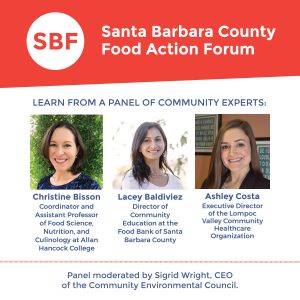BY SAM WATERSTONE | February 6, 2020
The Santa Barbara Foundation (SBF) understands that in order to solve any complex challenge, we must have a common understanding of its causes. As a resource for the county, SBF holds a series of community education forums each year that focus on important issues impacting Santa Barbara County. These events are designed to share knowledge and information with community members and connect them with community experts.
In the fall of 2019, SBF held two community education forums in connection to our Food and Shelter & Safety Grant Programs. The forums concentrated on the related issues of homelessness and food insecurity, while highlighting select projects and partnerships working to alleviate these challenges.

The first of two events was a Homelessness & Housing Forum held at the Foundation’s South County Headquarters. The Foundation’s Director of Grantmaking, Pedro Paz Ph.D., opened the forum with a detailed breakdown of the housing crisis affecting our county and our state. The data-oriented presentation contained some startling statistics connected to homelessness, housing and poverty, including that 14 percent of Santa Barbara County students are homeless and over 19 percent of children age 0-17 are living in poverty.
Paz discussed the myth that chronically homeless individuals make up the bulk of the homeless population. In our county, the majority of people experiencing homelessness are actually seniors, families, veterans, and former foster youth. Following the presentation, the forum shifted to a discussion led by a panel of community experts.
Panelists Rich Sander (Executive Director of the Santa Barbara Alliance for Community Transformation), Cassie Roach (Program Coordinator and Senior Case Manager for the Safe Parking Program at the New Beginnings Counseling Center), and Rob Fredericks (Executive Director and CEO of the Housing Authority of the City of Santa Barbara) discussed the creation of more affordable housing, the challenges facing shelter & safety-focused agencies, and how we must all work together to support vulnerable populations in our communities.
A large number of homeless families in Santa Barbara County have a license plate instead of a home address. These are members of our community who are forced to live in their vehicles because, while they may be employed (57% of homeless individuals are in the workforce), they cannot afford the high cost of housing. The panel also discussed the rise in unsheltered homelessness from 2018 to 2019, and shared how each of their organizations are tackling these tough issues. Finally, the panelists took time to respond to questions from the community members in attendance.

The second educational event was a Santa Barbara County Food Action Forum, held at SBF’s North County Headquarters. This convening followed a similar format as the Homelessness & Housing Forum, but focused instead on issues around food insecurity and projects connected to the Santa Barbara County Food Action Network (SBCFAN).
Paz described how people struggling with food insecurity are disproportionally affected by diet-sensitive chronic diseases such as diabetes and high blood pressure. He also mentioned that in Santa Barbara County, roughly 55,000 adults and 15,000 children are food insecure.
The panelists – all of whom serve on the SBCFAN Executive Committee – were Christine Bisson (Coordinator and Assistant Professor of Food Science, Nutrition & Culinology at Allen Hancock College), Lacey Baldiviez (Director of Community Education at the Food Bank of Santa Barbara County), and Ashley Costa (Executive Director of the Lompoc Valley Community Healthcare Organization). The panel was moderated by Sigrid Wright, CEO of the Community Environmental Council.

The panel focused on developments that came out of the Santa Barbara County Food Action Plan, a 2016 report that was funded by the Santa Barbara Foundation. During this portion of the forum, panelists engaged directly with community members, describing exciting new collaborations and programs dedicated to providing healthy, affordable and accessible food for all.
Through community education forums like these, the Foundation brings together experts in their respective fields with community members to discuss our county’s most pressing issues and explore innovative, collaborative solutions to those problems.
During both forums, Paz emphasized the importance of supporting nonprofits that provide effective Food, Shelter & Safety services for Santa Barbara County residents. He stressed that he and his team received proposals from many more qualified organizations than they were able to fund, demonstrating the need for increased financial support in these areas.
Ultimately, the Foundation granted a combined $638,000 to 16 organizations through the two grant programs. The Foundation takes pride in the substantial support it provides to local direct service providers through our grant programs, but the funding gap evidenced by these grant requests is proof that additional resources are needed to solve these longstanding community issues.
Listen and learn from the audio of the Homelessness & Housing Forum and the Santa Barbara County Food Action Forum.
2019 Food Grant Program Recipients
Community Action Commission of Santa Barbara County: $50,000
Cuyama Valley Family Resource Center: $30,000
Foodbank of Santa Barbara County: $50,000
Organic Soup Kitchen: $25,000
Santa Barbara Meals on Wheels: $5,000
Santa Ynez Valley Fruit & Vegetable Rescue: $23,000
Santa Ynez Valley Senior Citizens Foundation: $50,000
2019 Shelter & Safety Grant Program Recipients
Channel Islands YMCA, Youth and Family Services: $50,000
Domestic Violence Solutions: $50,000
Good Samaritan Shelter: $50,000
New Beginnings Counseling Center: $50,000
People Assisting the Homeless: $50,000
Santa Barbara Rescue Mission: $50,000
Transition House: $50,000
Unitarian Society of Santa Barbara: $40,000
Villa Majella of Santa Barbara: $25,000